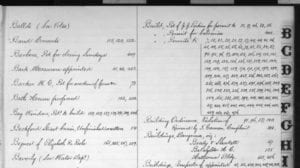Who is a member?
Our members are the local governments of Massachusetts and their elected and appointed leadership.

A scanned 1881 document from Salem’s Town Council records (before it had a city council).
Salem has launched an online portal that allows free public access to more than a million pages of current and historic city records, from public body meeting minutes to property records.
The portal, which holds records dating back 386 years, is the result of a partnership between the city’s Information Technology Department and the document management firm Laserfiche. Salem Chief Information Officer Matthew Killen started the project three years ago, with financial support from the city of Salem and a state Community Compact IT grant.
“Mayor [Kim] Driscoll was immediately on board,” Killen said. “We were very lucky to have had the financial support and the administrative support to make this happen.”
The digitization project allows city officials to both upload and search for documents in the database, eliminating the need for physical file storage.
“Certainly some documents need to be retained in their physical form,” Killen said, “but because they have been scanned and are easily shareable to anyone in the various departments, we could put all that in long-term storage in another location, without taking up important floorspace in department offices.”
The project has done much more than declutter office space, however.
“It also allows the public to do research on their own, to reduce the pressure on the department staff,” said Salem Application Analyst Robert Banks, who worked closely on the project. “You can go and research your own house and see when it was built, when it was transferred, and what building permits were taken out on it. And you don’t have to go to the Building Department to do it.”
In just the first two weeks after its launch, the portal had already seen 1,900 unique visitors, who had accessed more than 32,000 documents.
“There is a strong thirst for this kind of information in the public,” Killen said. “There is an immense segment of the population who is very interested in these kinds of records: genealogical records, historical land transfers, and all of those things that happened that turned Salem from a port where a few people stepped off of a ship 400 years ago into the thriving community that it is today.”
He added that the process wasn’t easy. Making the database searchable required use of Optical Character Recognition – specialized software that allows a computer to read documents.
“OCR works great for things that are typewritten, but any large scale drawings or handwritten records will not work,” Banks said.
Many older, handwritten records are much harder to work with.
The project also required the development of organization systems and search terms unique to each department.
“In order to make a project like this successful, it is important to work very closely with your internal departments,” Killen said. “You have to make sure that everyone understands essential components like document types, how they are indexed or searched, and how best to access them.”
The project is still expanding, and anticipates working with departments for years into the future.
“We’re still emptying file cabinets, and working with new departments,” said Banks. “We want to help preserve and build the story of Salem.”
Written by Elisa Sturkie